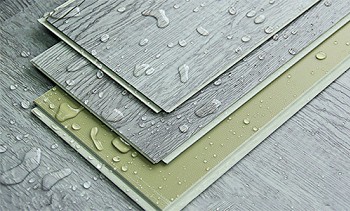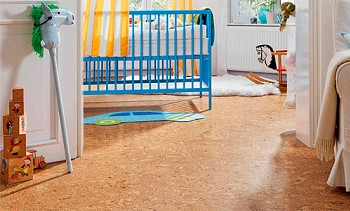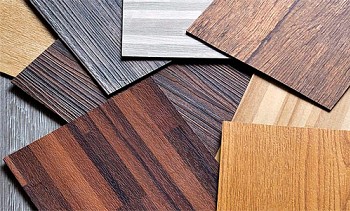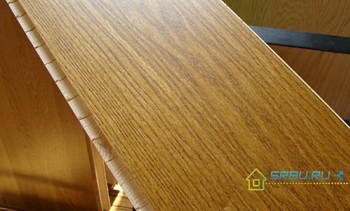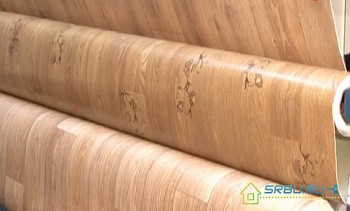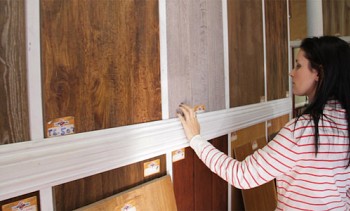On what flooring to choose, every owner who is faced with a repair is thinking about it. Of course, you can give preference for a long time to all the well-known and boring - linoleum, ceramic tile, carpet. But this may turn out to be a rather banal solution to the problem. After all, it is precisely about 90 percent of “repairmen” who acquire them, forgetting to take an interest in the latest innovations or at least get acquainted with the “pros” and “cons” of coatings they know.
So, once again, laminate (at fairly attractive prices), parquet (which is the representative of the most environmentally friendly floor materials), cork (capable of acquiring its original shape after deformation), and the appearance of the interior are not impressive. But the result of the repair can be much more original if you wisely use the existing innovations of the construction market. And by the way, there are quite a lot of them today.
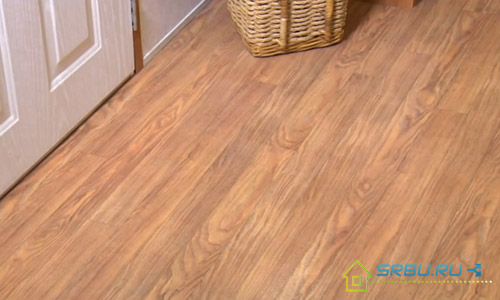
Faced with the choice of flooring, it should be remembered that materials with excellent characteristics should be used in spaces that are excellent in their functions. So, for example, the floor in the children's room and in the corridor should not be the same - the functions in these spaces are too different.
So, what flooring materials does the market offer us today, in which type of premises is it most appropriate to use them? Next, we will talk about both the familiar to all of us options, and about the rarely used exotic.
Requirements for flooring from various premises
Considering floor coverings for the house, we will talk about those materials that it is advisable to use inside the house, and not in household buildings such as a garage, a barn, etc. The object of attention will be living rooms and spaces of an economic nature (bathroom, kitchen, etc.). And you should start by considering the individual characteristics of the premises.
Hallway
Hallway - the first room where everyone who comes into the apartment gets into. It is here that most of the dirt, dust and sand settle, which can mechanically damage the floor covering. So it turns out that the material used in the hallway must be durable, resistant to moisture, not to deliver much effort during cleaning.
A bathroom
Toilet and bathroomwhere contact with the liquid is never ruled out, they require a wear-resistant floor covering with increased resistance to water, the cleaning process should not be a hassle.
Kitchen
Here, the material on the floor, like a toilet, should be durable and resistant to water. But this is not enough! It is easy and simple to remove dirt and oil and fat substances from it.
Balcony or loggia
Balcony / Loggia requires the use of durable flooring, resistant to sudden changes in temperature. These characteristics are quite enough if the balcony is converted into an additional room and represents a heated part of the space. In the absence of glazing, it is advisable to put materials on the floor that are also resistant to rainfall. Examples: tile, stone.
Living rooms apartments
Most of the time the inhabitants of the house and their guests spend in the living room, hall and dining room.So, the floor covering used in these spaces should be characterized by durability.
The floor material in the bedroom should be as environmentally friendly as possible, not accumulate a lot of dirt, easy to clean.
The nursery makes demands on the floor covering that are characteristic of both the living room and the bedroom at the same time. So, the material under the children's legs should be environmentally friendly, durable, ergonomic and, very importantly, safe in terms of the possibility of injury.
In addition to the characteristics inherent for floor coverings used in different purpose rooms, there are general requirements: ease of installation and affordable price. To understand in which space of an apartment the material of which plan will be most appropriate, you should first familiarize yourself with the existing varieties of floor coverings, their positive and negative characteristics.
Varieties of flooring
Technologies developed by specialists allow producing various types of floor coverings.
Among them:
- batten
- laminate
- parquet
- linoleum
- carpet
- tile
- marmoleum
- bulk floor
- cork floor.
What are the main characteristics of each species? Where is the most appropriate use of all of the above? So, first things first!
Batten
It is made from coniferous wood, after laying the floor is covered with paint or varnish to protect the material from abrasion. At a certain time interval, the decorative coating layer needs to be updated.
+ Benefits: ecological cleanliness, durability (thanks to the applied protective layer). It is also worth noting that plank flooring is easy enough to care for.
- Disadvantages: to qualitatively cover the floor with boards is not an easy task. Perhaps only a specialist can cope with it. As for the variety of design, the choice is very meager!

This is the glued floorboard.
Laminate
The laminate production technology is the processing of MDF panels with special resins, followed by gluing a paper layer on them. Then the resulting "semi-finished product" is pressed (this process occurs at high temperature) and varnished. Depending on the MDF panels used, the laminate is produced in different strengths. This criterion is the basis of the classification, according to which material is selected for laying in rooms of various types.
So, for living rooms, it is most appropriate to use a laminate of lower grades 21-23, and material for 31-33 grades will be most appropriate for a corridor and kitchen.
+ Benefits: fits very easily. If desired, anyone will cope with this task. It’s enough just to familiarize yourself with the laying rules, the material can help you with this:How to lay laminate step by step instructions". You can connect the panels by glue or glueless methods. The first option allows you to create a more durable structure, however, it will not be possible to disassemble it. The second option makes it possible to create a dismountable coating, which gives a chance to replace one of the panels in case of damage. On the laminate always antistatic coating is applied, which greatly facilitates the process of floor care.There are a lot of design solutions for this material!
- Disadvantages: low environmental friendliness (this is associated with the use of resins, impregnation and varnishes in production), instability with respect to water, poor ergonomics, durability depends on the class of the laminate. The most wear-resistant are high grades, which cannot but affect their price.

Laminate and its laying.
Parquet board and parquet
In the process of manufacturing parquet boards, a layer of valuable species of wood with a thickness of 3 to 5 mm is glued onto a wooden base. Installation of such flooring can be carried out in one of two options.The first is similar to the method of laying the laminate on glue, the second is the gluing of boards to the base.
Parquet is a separate small planks. They are laid mosaicly and fastened with a bridge to a previously prepared base.
+ Benefits: environmentally friendly and durable. Like many modern floor coverings, it is easy to install, easy to clean.
- Disadvantages: limited design (all variety is represented only by the appearance of natural wood).

Bonding parquet board.
Linoleum
Linoleum can be found on sale in the following types: sheets in rolls (width from 1 to 6 meters, thickness 1.5-5 mm) and in the form of tiles, the so-called PVC tiles. Laying linoleum is produced by gluing with the help of special adhesives. The laying surface must be carefully prepared. By the way, the main constituent component of this material can be: rubber, alkyd resins, nitrocellulose, and most often polyvinyl chloride.
+ Benefits: it is quite simple to install the coating, loyal requirements are made to the base, it is very easy to clean, the design is very diverse, absolutely all types of this material are moisture resistant. Good linoleum is also characterized by resistance to wear.
- Disadvantages: low ergonomics and environmental friendliness.

Linoleum flooring of increased strength.
Carpet
A relative of the carpet. The basis can be laid both natural and artificially synthesized components that can repel dirt and are characterized by a long service life. The release form and installation method are similar to linoleum.
+ Benefits: it is easy to mount, ergonomic and the injury is safe, the choice of colors is very large. If we talk about a carpet based on natural components, then it is also environmentally friendly.
- Disadvantages: short-lived, not resistant to moisture, makes it difficult to clean the room. Synthetic carpet is characterized by low environmental friendliness.

Carpet and an example of its joining with other coatings.
Ceramic, tile and porcelain tile
Ceramic tiles are becoming more and more fans. They put it on a special glue, and as a basis is a concrete screed.
+ Benefits: durability, environmental friendliness, resistance to moisture, simplicity during operation.
- Disadvantages: installation is complex, requires certain skills and experience; high risk of injury.

Ceramic tile and its laying process.
Marmoleum
It is made from natural ingredients. Among the main components are flaxseed, hemp and jute fiber. As additional substances are: vegetable oils, wood flour, resin of conifers and others. Even the dyes for the production of this flooring are exclusively natural. The release form is similar to roll linoleum or laminate panels.
+ Benefits: does not cause installation difficulties, does not impose special requirements on the base, has a long service life, and increased resistance to water. Does not cause trouble when cleaning the room. What is very important is purely natural material.
- Disadvantages: a sufficiently hard surface, hardening even more over time, provides a high level of injury risk.

Marmoleum and the process of laying it.
Bulk or liquid floors
The main components of liquid floors allow you to divide this coating into: polyurethane, epoxy, methyl methacrylate and cement-acrylic. Among the above named, the most environmentally friendly are cement-acrylic, but epoxy floors have the greatest design choice. The most rarely used are methyl methacrylate, as they are the most expensive.
+ Benefits: durability and environmental friendliness. Resistance to water and, importantly, to substances such as oil, chemicals, organic solvents. It’s easy to care for liquid floors.
- Disadvantages: low ergonomics and exactingness to the base during the installation process (it should be as even as possible, clean, dry).

An example of the implementation of a bulk 3D floor in the bathroom.
Cork floors
These are nothing more than veneer sheets or pressed crumbs of cork. Adhesive floors (sold in rolls, slabs) are glued directly to the base; floating are represented by sheets of MDF, on which a layer of “cork” is glued in the production process, these sheets are simply stacked.
+ Benefits: good sound insulation, environmental friendliness (due to underlying natural materials); big variety; simplicity in leaving. It is worth noting a very unusual characteristic - the ability to restore its form of deforming influences. Laying floating floors is quite simple. The advantage of an adhesive coating is its increased resistance to water.
- Disadvantages: covering the floors with an “adhesive cork” can cause certain difficulties; under them it is necessary to carefully level the base; A negative characteristic of floating floors is a low level of moisture resistance.

Cork flooring and the installation process.
The use of flooring depending on the premises
When deciding which coating is best used in the specific space of your house / apartment, you need to analyze what characteristics the floor should have and choose the most suitable material according to its properties.
Batten Suitable for spaces of almost any purpose. But do not put it where contact with water or with high humidity air is possible. Under such premises fall: balcony, corridor, kitchen, bathroom.
Laminate also used in spaces for various purposes (with the exception of the toilet / bathtub). The question when choosing it is only in what class of material will be the most acceptable. For rooms such as a bedroom, a laminate of class 23 is quite suitable, for the hallway, living room, dining room below 32, it is not recommended to use!
Parquet, similarly to a laminate, they are laid on all types of spaces of an apartment except for a bathroom, it can be safely used in children's rooms.
Linoleum, despite all its versatility, they try to avoid the bedroom and the nursery. As a rule, it is used in the hallway, in the kitchen, in the dining room.
Carpet based on natural components is perfect for children, but synthetic is used mainly in offices and offices.
Tile - an amazing option for use in commercial premises - a bathtub, toilet, often used in the kitchen.
Marmoleum can be used in rooms of almost any purpose, but gradually increasing rigidity excludes material from the list recommended for children.
Bulk (liquid) floors actively used in commercial spaces. Perhaps their use in the living room or dining room. Modern floors with three-dimensional image allow you to create an original and unique design.
Cork floors Suitable for any room. Even in the nursery they can replace the carpet. As for the corridor and the bathroom, then in them this coating is not recommended!
Of course, the choice of a particular material depends on personal preferences and the thickness of the wallet. But knowing what floor coverings for the apartment today are generally available, knowing their features and giving vent to imagination, you can create a special atmosphere. Believe me, seriously approaching the issue of choosing a material for the floor, a unique repair result can be guaranteed.
Summary table of flooring characteristics
| Types of flooring | Durability | Environmental friendliness | Design level | Easy to clean | Recommended Premises |
|---|---|---|---|---|---|
| Batten | + Good |
+ Good |
+- Middle |
+ Good |
Everything except: kitchen, bathroom, toilet, balcony |
| Laminate | +- Average |
+- Average |
+ Tall |
+- Average |
Rooms and bedrooms - 23 classes Entrance hall, living room, dining room - 32 - 33 classes |
| Parquet board or parquet | + Good |
+ Good |
+ Good |
+ Good |
Everything except: toilet, bathroom |
| Linoleum (high class) | + - Average |
- Low |
+ Good |
+ Good |
All except: children's rooms |
| Synthetic carpet natural |
- Low |
- Low + Good |
+- Middle |
- Low |
Office rooms Bedroom and nursery |
| Ceramic tile | + Good |
+ Good |
+- Middle |
+ Good |
Bathroom, toilet, kitchen, balcony |
| Marmoleum | + Good |
+ Good |
+ Good |
+ Good |
All except: children's rooms |
| Self-leveling floors | + Good |
+- Average |
+ Good |
+ Good |
Bathroom, toilet, living room, hallway, dining room |
| Cork floors | + Good |
+ Good |
+- Middle |
+ Good |
Everything except: toilet, bathroom, hallway |
Video: Features of flooring, PVC tiles and cork

